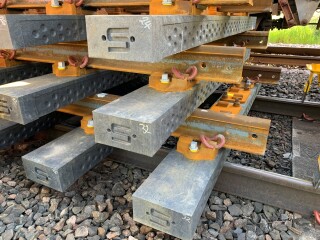Railway sleeps made from recycled waste plastic have been installed across the weight-restricted Sherrington Viaduct, between Salisbury and Warminster.
Previously, track across the viaduct would be fitted with wooden sleepers, as concrete would be too heavy for the structure. Hardwood is considered not sustainable and from next month creosote-treated softwood sleepers will be banned. On this viaduct, the only alternative is to use plastic instead of wood.
An EU-wide creosote ban in 2013 had an exemption for railway sleepers until 31st July 2021. Softwood sleepers will no longer be used in this country from that date.
The new rail sleepers are manufactured from locally-sourced plastic waste by Sicut Ltd in the UK, under licence from Rutgers University in New Jersey, USA. Sicut is using a blend of materials that might otherwise end up in landfill. The company has supplied its sleepers to railways overseas but this is its first UK contract.
Network Rail’s Wessex route director, Mark Killick, said: “This is an exciting development; use of these recycled sleepers on the Network Rail Wessex route is a first for the overground railway network in Britain. Rail is already one of the greenest ways to travel, but we’re committed to even greener and better journeys whether this be changing how we maintain the lineside or finding innovative ways to improve the railway by reusing materials and reducing landfill.”

Sicut chief executive William Mainwaring said: “Having proven that our products meet the performance required of modern rail track infrastructure we look forward to working closely with every Network Rail Route and Region to deliver the commercial and environmental savings promised by our technology, while at the same time helping the UK deliver on its commitments on carbon reduction and plastic waste proliferation.”
Network Rail said that the plastic sleepers were maintenance-free and recyclable. They do not split, rot or degrade and can resist water, oil, chemicals and fungi. Designed for more than 50 years of use, when they are eventually replaced, they can be re-used or recycled to make new sleepers or other composite products.
Concrete sleepers remain in use across most of the rail network, however. They are recycled by Network Rail at its March recycling yard, for construction aggregate and other purposes.
Got a story? Email news@theconstructionindex.co.uk



